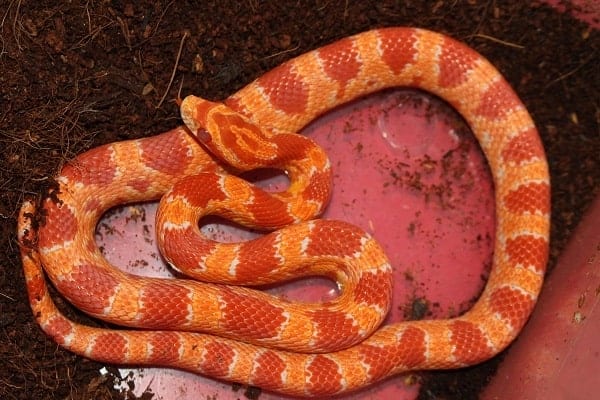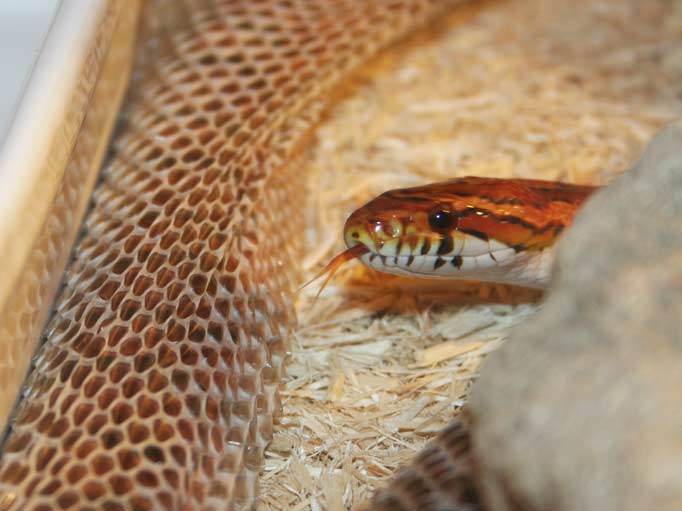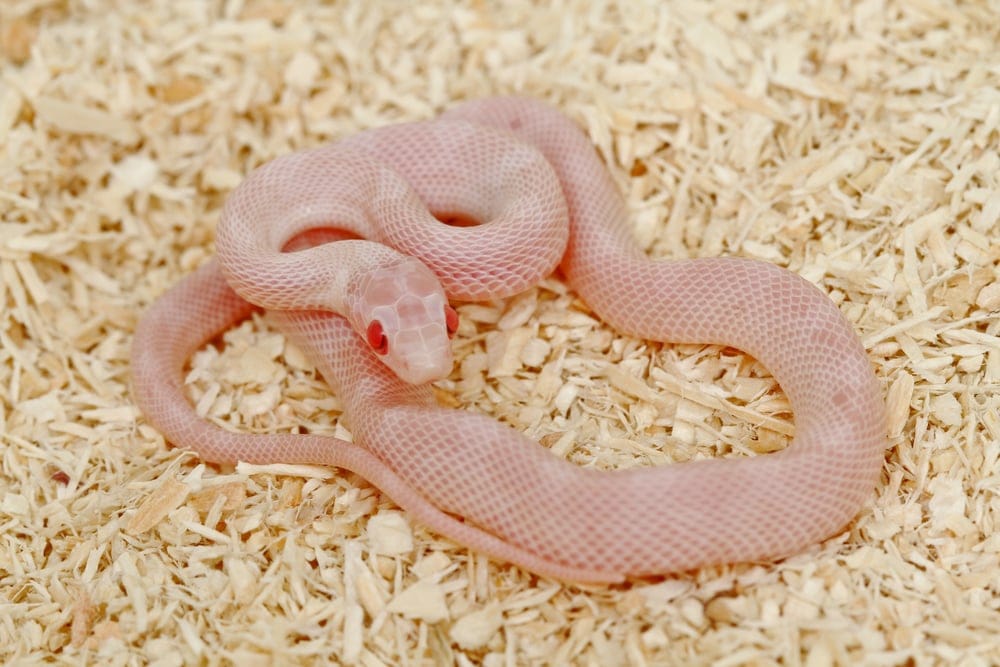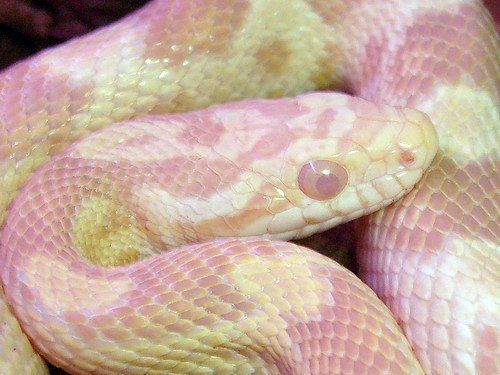Albino Corn snakes are well admired, due to their astonishing features, compliant nature, and easy maintenance.
Irrespective of the owner’s experience as a reptile keeper, corn snakes are easy to handle as they have submissive nature once properly trained.
Regarding their nutritional requirements, their diet is as simple as anything they get. They can live in a 40-gallon glass vivarium.
Do you want to learn more? Welcome here to a complete care guide for a beginner.
Appearance:
A-melanistic: lacking melanin in their pigmentation.
Colors:
Instead of being wholly white, they appear as pale red, pale orange or white replacing standard black markings on wild corn snakes. Their dorsal side has orange banding which is well crafted with red saddle lines in between with an ending as a white underbelly. Which gives them a striking red-orange pattern.
The most loveable features of albino snakes are markings extending onto their heads, creating a triangular image on their top and captivating red eyes.
Morphs:
While itself being a morph, other varieties having different markings include reverse okeetee and creamsicle morph.
Size for Age:
Newly hatched albinos are small and merely up to 15 inches i.e 40cms. Their growth mostly occurs in the first year of their life and continues during the next year. Till 2 years of age, they grow up to 3-5 feet.
However, the adult size they can achieve is up to 5 feet maximum, as some snakes continue growing after two years but that growth is slow and steady and unnoticeable.
The weight of albinos varies according to age as well as size. However, there is no breed standard.
Difference between Male and Female:
There is no distinguishing feature that separates a male from a female unless probing or popping of snakes is done. The presence of hemipenis categorizes a snake as a male and vice versa.
Lifespan of Albino Corn Snakes:
The lifespan of an albino snake depends on the habitat of the snake i.e in the wild they have a clear disadvantage of striking colors as they cannot camouflage themselves into their natural habitat. This decreases the lifespan of wild albino corn snakes. In the wild, they only have a lifespan of 3 to 7 years, in general.
On the other hand, pet albinos have a clear advantage of no danger of predation, they have longer lives up to 15 to 20 years on average. However, maintenance of optimum conditions of habitat is the best way to achieve maximum life span for your pet.
Husbandry & Care Guide:
Mostly corn snakes, wild ones are inhabitants of forests and healthy areas. They are typically non-arboreal; however, they can travel some small branches of plants and trees. They are active species mainly throughout the year; however, it is noticed that they hinder their activities during the winter season and hide in burrows, tree holes, and abandoned areas.
Their habitat is very simple so replication of it is not difficult and easy to maintain. Here all guidelines are mentioned that can be used by any beginner interested in keeping albino snake.
HABITAT- of an Albino Corn Snake:
TANK SIZE:
The size of the tank depends on the age and size of the snake i.e for a newly hatched snake a shoebox-sized container is more than enough. However, as the snake grows the requirement for space increases up to 20–40-gallon glass vivarium with a screened lid for an adult albino corn snake.

Tank Mates:
Economically, it look likes a good idea to house two or more corn snakes together, however, due to solitary nature can put your pet in following risks:
Hatchlings are not fixated to one specific food and therefore can be “Cannibalistic” and can eat companion snakes of the same size and you will end up losing both participants.
Putting two or more corn snakes together can result in stress on both cage-mates and both end up eating each other.
So housing other snake species with albino corn snakes is just out of question.
TEMPERATURE:
The temperature should be ranging from 70-85 degrees Fahrenheit; however, one side of the tank should be at a higher temperature (80-85 degrees Fahrenheit) and the other one at a lower temperature (70 to 76 degrees Fahrenheit).
There should be at least two hide boxes in a tank, which will encourage a sense of exploration of your pet. One of them should be specified for shedding. The shedding hide box should be placed on the warmer side of the tank.
HUMIDITY:
The humidity of the tank should be kept between 65 to 75%, for this purpose placing moist moss in the tank should be done. Particularly in shedding hide, it will make the shedding easier for your pet.
LIGHTING:
Lighting requirements are approximately nil i.e., natural lighting patterns are perfect; however, the Tank should not be placed in direct sunlight, which’s intensity and position you obviously can’t control.
SUBSTRATE:
As an albino snake loves a humid environment, as well as the humid environment, makes shedding easier thus substrate should be suitable for retaining the moisture For Example coconut fiber, aspen shavings (highly-absorbent shavings make ideal bedding material as well as they are scent-free), Newspaper and paper towels are also good for this purpose as well as cheap and pocket friendly.
Cleanliness of Enclosure:
The cleanliness of the provided environment is crucial for your pet’s health. It is important to clean the spot daily and replace the wet or soaked substrate.
Replace any areas of the substrate that are wet or contain feces and change whole bedding once a month.
A thorough cleaning should be done after every 1-2 months, which includes maintenance of all conditions described above.
SUMMARY TABLE
| Species Name: | Pantherophis guttatus guttatus. |
| Common Name: | Amelanistic Corn Snake, Amel Corn snake |
| Care Level: | Beginner |
| Life span: | 15-20 years |
| Adult Size: | 4-5 feet / 300-800 gram |
| Nutrition: | Mice/ rats (dead or thawed) |
| Minimum space required: | 20–40-gallon tank (glass vivarium) |
| Temperature & Humidity: | 70–85-degree Fahrenheit |
NUTRITION:
owners dust their feeds with calcium and vitamin D3 to make up for not getting enough sunlight, whereas its benefit is still under debate.In General, “Carnivorous”: Albino corn snakes are carnivorous, and their Nutritional requirement is as simple as it can be i.e.
- Small Rodents (rats, mice, frogs, and other snakes)
As they are primarily non-venomous snakes, this factor renders their ability to prey on themselves. So, you have to buy dead or frozen rodents to make up for their nutritional requirements.
However, their nutrition depends on age primarily and each snake has its own requirement regarding its diet so adjust accordingly.
- Newly Hatched: should be fed on live mice as they require time to adjust to frozen/thawed. Whereas they should be fed once every week with food.
- Young Ones: can be fed by a small adult mouse or pinky mice once a week.
- Adults: can be fed on medium to large-sized mice once in 7 to 10 days.
Clean water is another requirement for your pet, so it should be available always. The position of the water bowl should not be high so it can easily be tipped over or too deep. Water should be changed daily or when dirty.
Diet Summary:
| Constituent: | Percentage of diet: |
| Meat: | Main source i.e., 100% |
| Insects: | 0% of diet |
| Fruits: | 0% of diet |
| Supplements: | Calcium, vitamin D3 (optional) |
Health Concerns:
Albino snakes are usually sturdy species and are well known for this fact as well as easy maintenance making them one of the favorite pets of first-time owners.
However, the cleanliness of the provided environment is crucial for your pet’s health. Common health issues include
- Parasites: (mainly a concern if you feed your pet with wild-caught rodents, however, feed consisting of captive pre-killed mice significantly decreases this risk)
- Mouth rot: (infection of mouth due to poor or dirty environment, an injury leading to bloody mucus coming out of mouth or swollen mouth)
- Respiratory issues: leads to labored breathing.
Later both issues lead to refusal of feed by your pet, however, if more than two meals are refused in a row immediately consult a veterinarian.
Another health concern regarding albino corn snakes is shedding complications. An albino corn snake typically sheds every few weeks. If part of your snake’s shed remains on their body, bathing your snake with lukewarm water helps, as this process is facilitated by humidity.

| Signs of Health: | Symptoms of Illness: |
| Active, Exploring | Hiding for prolonged periods |
| Slim, full shedding | Incomplete shedding |
| Clear eyes | Tongue flicking Inability to take food |
| regular breathing | Labored breathing |
Brumation:
Hibernation typical of reptiles also occurs in albino snakes. This subtype of hibernation is not true hibernation but a cold-blooded version of slowing down during low temperatures. This phenomenon occurs in the natural environment, however, if you maintain the temperature of a tank in the correct zone there is no need to worry about brumation.
Handling Advice:
Handling your pet is important for the promotion of your pet’s tameness as well as stimulation, handling sessions should not be greater than a few minutes in starting and let your pet calm down before returning to its enclosure. Later you can extend your session time progressively.

In starting before any handling/interaction with your pet it’s important to let them adjust, as your pet is in an entirely unfamiliar environment. So, allow your pet to adjust to their new environment for a few weeks, and when they become comfortable start slow initiation of handling/interaction.
For starters, never approach your pet from above, always start initiation from the side. Support your pet’s body weight and never restrict the head or grab its tail. Albino corn snakes are submissive and inquisitive so love to explore while being handled.
Start with short sessions of 2-5 minutes, then progressively increase up to 10 minutes and finally up to half an hour. Any handling/interaction session should never be more than an hour. After each handling session, the snake should always be put back into the enclosure.
It is important to make at least two handling/interaction sessions in a week to keep them familiar with human interaction as well as it is easier to tame your pet.
The characteristic color of an albino’s eye is striking red but when it is shedding, its eyes have a blue-ish gaze. You should avoid interaction with your pet in this condition, as vision is hindered and therefore a greater chance of your pet being startled.
Breeding:
Albinos are typically OVIPAROUS i.e., egg-laying species, from which the new offspring hatched. Parents take responsibility for only egg-laying as there is no care provided by either the maternal or paternal side till the egg hatching.
Newly hatched snakes appear dull but with time they take typical colors due to the development of scales.
The best time of breeding is after brumation. In an artificial environment, it is achieved by progressively decreasing both temperatures as well as feeding during the months of November till February. Afterward, a gradual increase in temperature along with feed is required for energy build-up and strength for mating.
Shedding of males and females is not synchronous, females typically shed 2 weeks after the male, and it is an indication for mating.
Females produce pheromones to attract males and this process in an artificial environment is facilitated by increasing humidity.
During each mating, session snakes remain intertwined for 20-30 minutes, followed by the return of the male to the hiding shed.
Females remain gravid for approximately 4-6 weeks followed by egg-laying. A female on average lays 12 eggs at a time.
Incubation: the optimum temperature for incubation of eggs is 78-80 °F. approximately 6 to 8 weeks are required by eggs to hatch.
To ensure the health of your pet, as well as offspring “Mating”, is recommended only once a year.
Nature of Albino Corn Snake
In natural environments due to their reclusive nature they don’t interact much except in breeding season in which they compete for females. Being submissive in nature they are mainly nocturnal i.e., mostly active during the night for prey.
However, in the artificial environment, they may spend their whole day hiding in one of the hide boxes and be most active during the night. Being curious is usually found to be exploring the surroundings of their habitat.
Communication
One of the basic instincts of albino corn snakes is the use of body language as means of communication i.e., how are they feeling to humans and the other snakes:
- Tongue flicking: is mainly the normal behavior and a way of sensing other snakes in surroundings.
- Tail rattling/shaking and hissing: area indicative of snakes interpreting some threat and gives a signal to keep distance.
Pricing & What to Expect
The price of a snake depends on several factors which include:
- Age
- Sex
- Size
- Colors & markings
- Place of purchase
However, you can expect an average cost of up to $40-$60 USD.
Points to Consider While Purchasing Include
- Active and agile
- Either move properly or not
- comfortable
Ask breeders questions like what feed they provide, any human interaction has done before.
Look for tongue flicking, as this is a part of the albino’s normal behavior.
Also look for clear characteristic eyes, as your pet must be healthy when you purchase it.
Albino Corn Snakes as Pets:
One of the characteristic features of albinos is that they are non-venomous i.e., non-poisonous so it is suitable for children. Along with submissive and adaptive nature make them one of the Favourite pets of pet owners, especially beginners.
Other than that, eye-catching colors are what make anyone buy albino corn snakes.
Summary:
Pros and cons:
| Pros | Cons |
|---|---|
| Submissive nature | Short lifespan |
| Best for beginners | Not interactive with other snakes so must be housed individually |
| Simplest diet | Requires time to get familiar with humans |
Albino corn snakes are best as well as perfect for beginners. Their lack of pigment along with distinctive and attractive color patterns make them beautiful and eye-catching.
No special habitat and nutritional requirements make them the easiest pets.
Similar breeds like milk snake, kingsnake, and garter snake all have specific requirements regarding habitat and nutrition so make sure what you want and handle before you get anything home.








